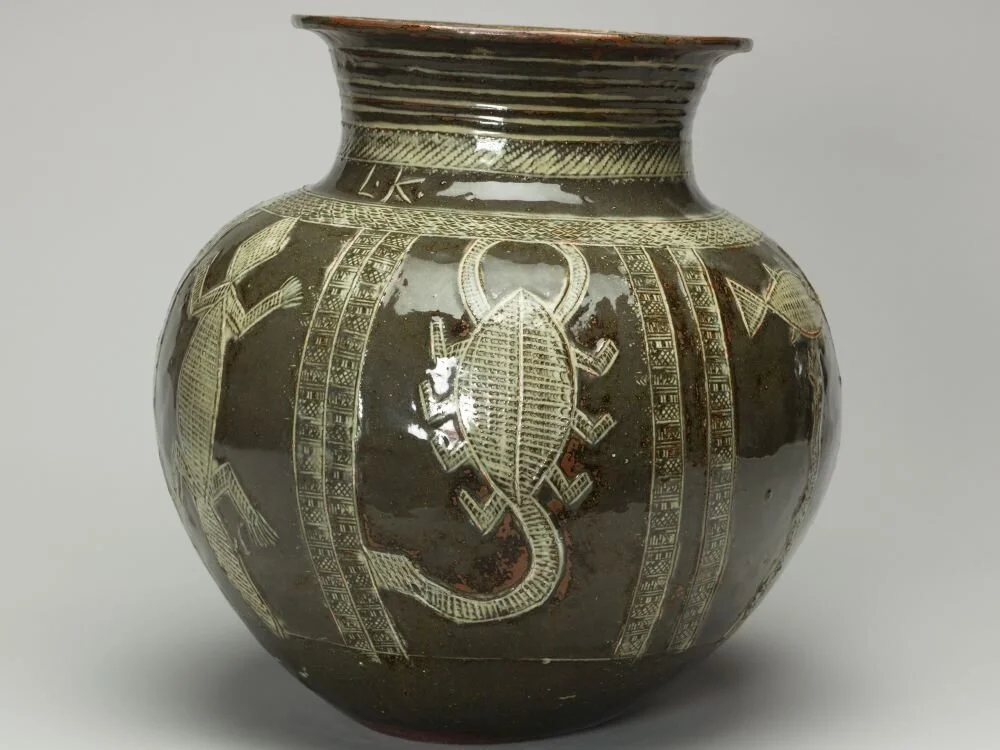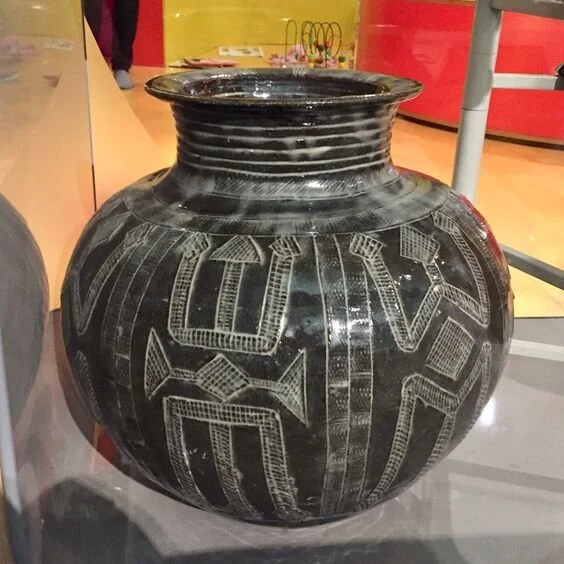Lady Kwali: A Synthesis of Indigenous and Modern
By Alayo Akinkugbe
Ladi Kwali (1925-1984) was one of the first Nigerian potters to achieve international recognition as a coil pottery artist, and her works engage with both indigenous pre-20th century traditions and twentieth century Nigerian modernism. Born in the village of Kwali, in the Gwari region of central Nigeria, her earliest works were influenced by the pottery of the Gbagyi ethnic group, part of an ancient Nigerian tradition of work in clay which includes the terracotta sculptures of the Nok. Although ceramics are frequently labelled as ‘craft’ as opposed to art in Western narratives of art history, the perception of Kwali in Nigeria, and arguably internationally, is very much as an artist and not as a craftswoman. Her works can be found in eminent private art collections in Nigeria, and in major museums abroad, such as the British Museum, and the Smithsonian Institution.
Lady Kwali at work in Abuja ca. 1970?
Kwali’s preferred technique was coiling, a method of making pottery that has been used across cultures for thousands of years including, but not limited to, those in Africa, China and the Americas, to shape clay into vessels. Pottery fragments on archaeological sites have suggested that the method of coiling was employed as early as c.7000 BCE. The process involves a pliable material such as clay, being rolled into a long malleable cylinder to form a coil. The body of the vessel being created is moulded by hand when the clay is still soft, with one coil placed on top of another, joined by pressure from the artist’s hands rather than applying a slip to the surface. The vessel is then sundried and fired either in an open fire, pit or kiln. Although many vessels made by this process can be found in museums, they were functional, in the Nigerian context specifically, for carrying water and storing food in rural communities.
Detail of circular relief (Nok culture), 500 BCE - 500 CE, terracotta, Musée du Quai Branly, Paris. Photo: Wikimedia. AFP: Shah Marai This sculpture was bought in 1998 by the French government from a Belgian dealer. Although its ownership has now been transferred to the Nigerian government, it remains in France on loan for at least 25 years.
GOOGLE ARTS AND CULTURE: VESSEL LADY KWALI
Placing a lump of clay on a circular plinth, usually made from the hard skin of a calabash fruit, Ladi Kwali pounded the clay with her fist to make the shape of a bowl, pulling the clay upward to form the wall of the vessel. Once the clay was at the right thickness, she would add coils to the inside of the pot, dragging the clay up to create height and width. She produced her works whilst standing and would walk around each vessel as she built it, as opposed to using a pottery wheel. The decorations for her vessels were traditional images, usually of animals such as lizards, birds and fish, which she created by drawing an outline with a knife then using a cylindrical wooden tool (a roulette) to add texture to the design. In keeping with traditional Gbagyi methods, her works were fired in an open bonfire of dry vegetation.
Ladi Kwali was born into a family that kept up with the regional tradition of females making pottery. She first trained with her aunt, who taught her the method of coiling that she employed throughout her career. A turning point in her career occurred when she joined the pottery training centre in Abuja, established by Michael Cardew in 1951, the British ceramicist who held the post of pottery officer under the colonial Nigerian government. Kwali was the first female potter at Abuja Pottery, and while there she learned wheel throwing, glazing, kiln firing, the use of slip and the production of saggars, and she eventually became an instructor.
Lady Kwali, Water jar, handbuilt, coiled pot with green glaze with sgraffito , ca. 1962, Bristol Museum & Art Gallery. Photo: Estate of Lady Kwali
Although Kwali learnt wheel-throwing from Cardew, she continued to employ the traditional free-hand technique of coiling, using the stoneware clay from the centre to create her vessels. Kwali made vessels with sgraffito decoration, produced by dipping the clay object in a red or white slip, then incising the decoration through the slip, with a porcupine quill to reveal the body underneath. Kwali also used white kaolin and feldspar slip to fill in the traditional decorative incisions and fired her pots with a celadon glaze. The vessels made by Kwali after joining the Centre are seen to represent a synthesis of Gwari pottery techniques and Western studio pottery by nature of being hand built and decorated with both traditional incisions and the use of a slip, as well as being fired in a high temperature kiln as opposed to the open bonfires of her early work. Kwali’s virtuosic synthesis of indigenous and western pottery traditions led to her success both nationally and internationally, and she is the only woman to occupy a place on Nigerian currency, with a portrait of her at work printed on one side of the 20 Naira note.



